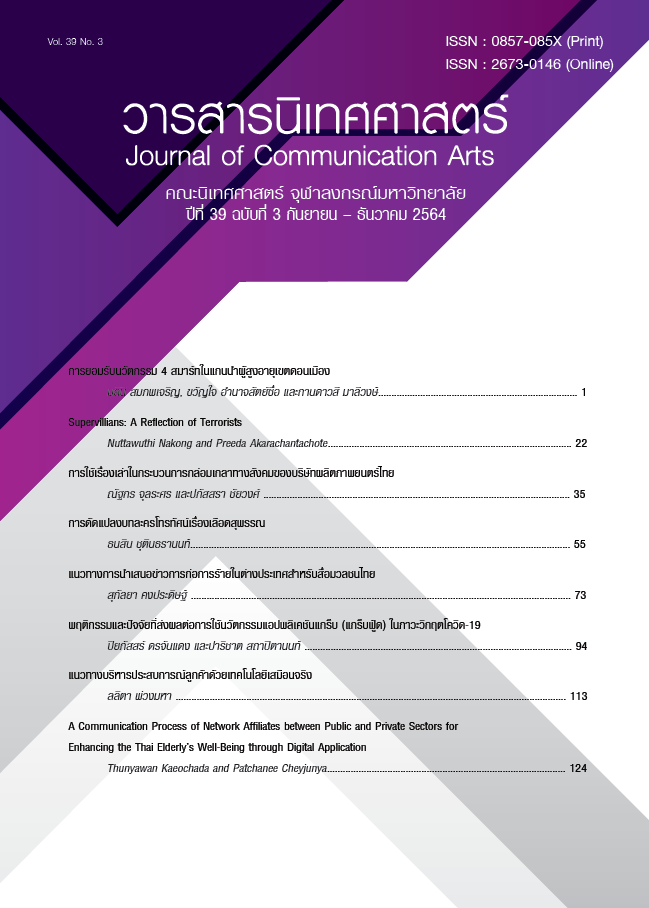4 Smarts’ Innovation Adoption in Elderly Club Leader, Don Mueng District
Main Article Content
Abstract
This research is a mixed-method model consisted of quantitative research and qualitative research. The objective was to study the process of diffusion innovation in the 4 SMART curricula, namely, do not depression, do not fall, do not forget, and enjoy eating among the leaders of the Elderly Club in Don Mueang District for the benefit of bringing knowledge of all 4 Smart to expand these curricula toward the members of the elderly club for healthy well-being. The research process started with 14 senior elderly club leaders, trained a 4-SMART course for two days, and collected data using the 4 SMART assessments and participatory observation. Team researchers play the facilitator's role in supporting 4 SMART training, including following elderly leaders to observe and organize activities to disseminate knowledge trained to their members of the elderly club. The 4 SMARTs analyzed by using frequencies. It found that 13 cases as a malnutrition risk assessment inferred that the elderly were likely to fall in the future, even though the fall assessment results were low for all club leaders. However, it found that many factors may increase the risk of falling in the future, such as living in a house with a raised platform height of 5.1 meters or more or 2 -floored house, routinely medical drug consumption. Results from the innovation adoption process of elderly club leader in qualitative research found that they used interpersonal communication and line application due to text and picture transmission with fluency, low-cost, over-expectation according to the Technological Acceptance Model premise (TAM). In conclusion, It integrated interpersonal communication through face-to-face communication and social media like line application to disseminate health messages for older adults' well-being. Moreover, the leaders in some clubs are female. In terms of the depression assessment, and there was no cause of depression. The results of this study can use as a preventive guideline for elderly health. Because the elderly has poor nutrition will lead to dementia, falling and depression in the future.
Article Details
References
กรมกิจการผู้สูงอายุ กระทรวงพัฒนาสังคมและความมั่นคงของมนุษย์ คณะแพทยศาสตร์ศิริราชพยาบาล ศูนย์การแพทย์
กาญจานภิเษก มหาวิทยาลัยมหิดล. โภชนาการสำหรับผู้สูงอายุ. วันที่เข้าถึงข้อมูล 6 ธันวาคม 2563 แหล่งที่มา www.gj.mahidol.ac.th/main/knowledge-2/nutrition/
กองยุทธศาสตร์สาธารณสุขและสิ่งแวดล้อม สยป. กรุงเทพมหานคร. รายงานข้อมูลผู้สูงอายุของกรุงเทพมหานครจากฐานประชากรในระบบทะเบียนราษฎร ณ เดือนธันวาคม 2561 และเปรียบเทียบกับข้อมูล ณ เดือนธันวาคม 2560. วันที่เข้าถึงข้อมูล 12 ธันวาคม 2563 แหล่งที่มา http://www.bangkok.go.th/upload/user/00000132/download/22_02_fullpaper.pdf
กานดาวสี มาลีวงษ์ และคณะ (2561) ความรอบรู้สุขภาพของชมรมผู้สูงอายุเพื่อส่งเสริมสุขภาพผู้สูงอายุ “ไม่ล้ม ไม่ลืม ไม่ซึมเศร้า กินข้าวอร่อย” กรณีศึกษาเขตดอนเมือง. วารสารเกื้อการุณย์, 25(2). 119-136.
จินตนา สุวิทวัส.(2561). การประเมินภาวะโภชนาการ. ขอนแก่น : เพ็ญพริ้นติ้ง.
จุฬารัตน์ ห้าวหาญ ชัยวัฒน์ อ่อนไธสง วีระพงษ์ เปรมสถิต. (2561). ปัจจัยทำนายความเสี่ยงต่อภาวะหกล้มในผู้สูงอายุเขตภาคตะวันออกเฉียงเหนือ. วารสารวิทยาลัยพยาบาลพระจอมเกล้า จังหวัดเพชรบุรี, 1(1), 26-38.
ดาราวรรณ รองเมือง, ฉันทนา นาคฉัตรีย์, จีราพร ทองดี, และจิตติยา สมบัติบูรณ์. (2561). อุบัติการณ์ ของ การหกล้ม และ ปัจจัยที่มีความสัมพันธ์กับการหกล้มในผู้สูงอายุที่อาศัยในชุมชน จังหวัด สุราษฎร์ธานี. วารสารวิทยาลัยพยาบาลพระปกเกล้า จันทบุรี, 27(3), 123-138.
ตรีธันว์ ศรีวิเชียร. (2559). การศึกษาภาวะโภชนาการและปัจจัยที่เกี่ยวข้องกับการเกิดภาวะทุพโภชนาการของผู้สูงอายุที่อาศัยในพื้นที่รับผิดชอบของศูนย์แพทย์ชุมชนป้อมเพชร. วารสารสมาคมเวชศาสตร์ปัองกันแห่งประเทศไทย, 6(2), 119-130.
ทิตยาวดี ศรีพนม. (2551). การพัฒนาบริการส่งเสริมสุขภาพผู้สูงอายุในเขตเทศบาลเมืองบุรีรัมย์. วิทยานิพนธ์ปริญญาพยาบาลศาสตรมหาบัณฑิต สาขาวิชาการพยาบาลอนามัยชุมชน, บัณฑิตวิทยาลัย มหาวิทยาลัยขอนแก่น.
ธัญพร ชื่นกลิ่น; นงณภัทร รุ่งเนย; นภัส แก้ววิเชียร; เบญจพร สุธรรมชัย; วิชาญ เกิดวิชัย; ศุภสิทธิ์ พรรณารุโณทัย. (2563) การประเมินผลการดูแลสุขภาพระยะกลางของผู้สูงอายุในประเทศไทยตามนโยบายของกระทรวงสาธารณสุข. สถาบันวิจัยระบบสาธารณสุข.
นงนุช วรไธสง. (2551). การศึกษาปัจจัยเสี่ยงต่อการหกล้มของผู้สูงอายุกลุ่มเสี่ยงที่อาศัยอยู่ในชุมชน จังหวัดขอนแก่น. วิทยานิพนธ์ปริญญามหาบัณฑิต, มหาวิทยาลัยขอนแก่น.
นันทวัฒน์ ภัทรกรนันท์.(2559). ศาสตร์และศิลป์การสอนผู้ใหญ่. วารสารศึกษาศาสตร์, 14(2). 40-53.
ปิ่นนเรศ กาศอุดม และมัณฑนา เหมชะญาติ.(2554). รายงานการวิจัย ผลของโปรแกรมการส่งเสริมพฤติกรรมสุขภาพของผู้สูงอายุ ในเขตเทศบาลตำบลบางกะจะ อำเภอเมือง จังหวัดจันทบุรี. วารสารวิทยาลัยพยาบาลพระปกเกล้าจันทบุรี, 22(2), 61-70.
ปิยะ ศักดิ์เจริญ. (2558). ทฤษฎีการเรียนรู้ผู้ใหญ่และแนวคิดการเรียนรู้ด้วยการชี้นำตนเอง : กระบวนการเรียนรู้เพื่อการส่งเสริมการเรียนรู้ตลอดชีวิต. วารสารพยาบาลทหารบก, 16(1). 8-13.
มะลิ โพธิพิมพ์, วลัญช์ชยา เขตบำรุง, จุน หน่อแก้ว, จิรวุฒิ กุจะพันธ์. (2562). ประสิทธิผลของโปรแกรมสร้างเสริมพฤติกรรม.
มูลนิธิสถาบันวิจัยและพัฒนาผู้สูงอายุไทย (มส.ผส.).(2559). รายงานสถานการณ์ผู้สูงอายุไทย พ.ศ. 2559. วันที่เข้าถึงข้อมูล 12 ธันวาคม 2563 แหล่งที่มา http://www.dop.go.th/download/knowledge/th1512367202-108_0.pdf
วิกรม รุจยากรกุล. (2560). ปัจจัยที่มีความสัมพันธ์ต่อการดำเนินงานของชมรมผู้สูงอายุคุณภาพ จังหวัดนครปฐม. วิทยานิพนธ์ปริญญาวิทยาศาสตรมหาบัณฑิต (สาธารณสุขศาสตร์).
สมาคมสภาผู้สูงอายุแห่งประเทศไทย. (มปป.) คู่มือชมรมผู้สูงอายุ. กรมพัฒนาสังคมและสวัสดิการ. กรุงเทพมหานคร.
สวรรยา ธรรมอภิพล,นันทิชา อ่อนละมัย,จรรยพร ตันเจริญ. (2561). ปัจจัยความสำเร็จของชมรมผู้สูงอายุบ้านไร่แค จังหวัดเพชรบุรี. Veridian E-Journal, Silpakorn University.11(2).352-365.
สุขภาพต่อความรู้ ทัศนคติและการปฏิบัติสร้างเสริมสุขภาพ ในสมาชิกชมรมผู้สูงอายุ จังหวัดนครราชสีมา. วารสารสาธารณสุขมหาวิทยาลัยบูรพา.14(1). 119-130.
สุขภาพผู้สูงอายุและความพึงพอใจในการมีส่วนร่วมของผู้ที่ให้การดูแลผู้สูงอายุ.รายงานการวิจัย วิทยาลัยพยาบาลบรมราชชนนี พระพุทธบาท.
อมาวสี อัมพันศิริรัตน์ พิมพิมล วงศ์ไชยา. (2560). การวิจัยเชิงปฏิบัติการแบบมีส่วนร่วม : ลักษณะสำคัญและการประยุกต์ใช้ในชุมชน. วารสารมนุษยศาสตร์และสังคมศาสตร์ มหาวิทยาลัยมหาสารคาม. 38(6). 192-202.
อรวรรณ แผนคง และสุนทรีย์ คำเพ็ง. (2551). ผลของการส่งเสริมสุขภาพโดยใช้ชุมชนเป็นฐานต่อพฤติกรรมการส่งเสริม.รามาธิบดีพยาบาลสาร, 16(1), 1-13.
Archer, D. & Cameron, A. (2009). Collaborative leadership: building relationship handling conflict and sharing control. NY : Routledge.
Coto, Mayela., Fulvio, Lizano, Sonia Mora, and Jennifer Fuentes. (2017). Social Media and elderly People: Research Trends. Conference Paper, May 2017.
Crainer, S. and Dearlove, D. (2014). Leadership: Organizational success through leadership. McGrawHill Education.
Dearing, J. W. (2009). Applying Diffusion of Innovation Theory to Intervention Development. Research on social work practice, 19(5), 503–518.
Endriulaitiene, A., Stelmokiene, A., Geneviciute-Janoniene, G., Gustainiene,L., Jarasiunaite, G. and Buksnyte-Marmiene, L. (2017), Attitudes of staff members towards development of elder care organizations: The role of leadership effectiveness in private and public sectors, International Journal of Public Leadership, 13(1), 40-50.
Eun Hwa Jung, S. Shyam Sundar. (2021) Older Adults’ Activities on Facebook: Can Affordances Predict Intrinsic Motivation and Well-Being?. Health Communication. DOI: 10.1080/10410236.2020.1859722
Gans, K.M. et al. (2015). Innovative video tailoring for dietary change: final results of the Good for you! Cluster randomized trial. International Journal of behavioral nutrition and physical activity, (12): 130.
Janio, E. A., & Sorkin, D. H. (2020). Food insecurity and healthcare access, utilization, and quality among middle and later life adults in California. Journal of Aging and Health. 33(3-4), 171-186
Madden, M. (2010). Older adults and social media: social networking use among those ages 50 and older nearly doubled over the past year. Pew Research Center.
Quinn, K. (2018). Cognitive Effects of Social Media Use: A Case of Older Adults. Social Media + Society. 4 (3).
Rebecca, B., Stephanie, S., Tommy, J., Mary, A. J., Arvine, B. & Jung Sun Lee. (2010). Food Insecurity Is Associated with Cost-Related Medication Non-Adherence in Community-Dwelling, Low-Income Older Adults in Georgia, Journal of Nutrition For the Elderly, (29)2, 170-191.
Rebecca M. Chory-Assad & Ashley Yanen (2005) Hopelessness and Loneliness as Predictors of Older Adults' Involvement with Favorite Television Performers, Journal of Broadcasting & Electronic Media, 49(2), 182-201.
Smith, R. A., Kim, Y., Zhu, X., Doudou, D. T., Sternberg, E. D., & Thomas, M. B. (2018). Integrating Models of Diffusion and Behavior to Predict Innovation Adoption, Maintenance, and Social Diffusion. Journal of health communication, 23(3), 264–271.
United Nations, (2013), World Population Ageing: 2013. United Nations, New York.


